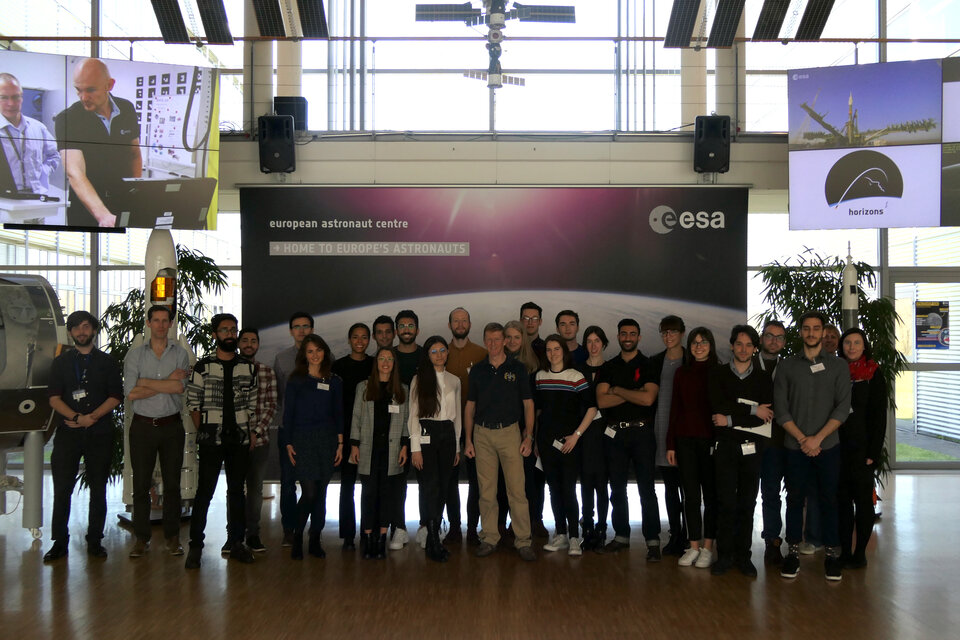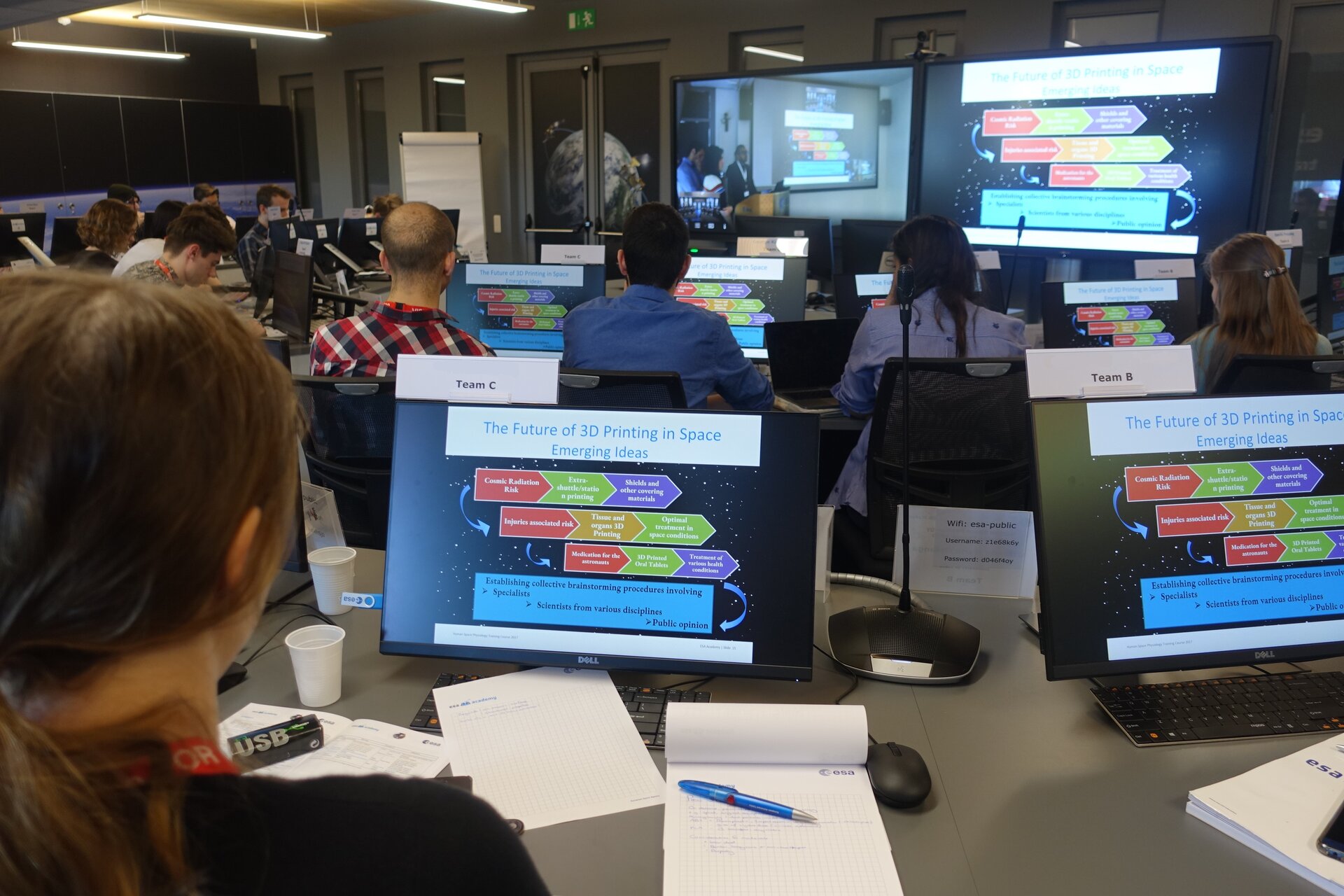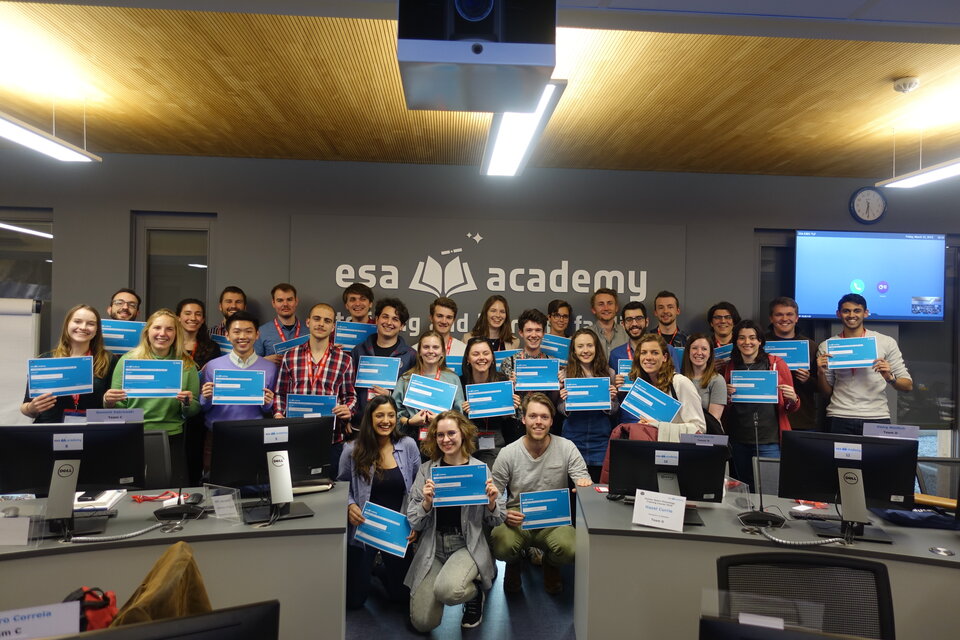Students aim for the stars in the Human Space Physiology Training Course, 2019 edition
50 university students from 13 different Member States and Canada (an Associate State) recently participated in a challenging training course about human life in space. The 2019 edition of the Human Space Physiology Training Course, held from 19 to 22 March, was a collaboration between ESA’s Education Office and Space Medicine Team. Some of the students and experts travelled to ESA Academy’s Training and Learning Facility, European space Security and Education Centre (ESEC- Galaxia), Transinne, Belgium; and the others to the European Astronaut Centre (EAC), Cologne, Germany. The groups at each host site were linked together via videoconference in order to provide a fantastic opportunity for the University students to develop their skills and the experts to share their knowledge.
“It was wonderful to work with a group of like-minded people from across Europe,” said a British student from the University of Nottingham. “I learned not only about human physiology, but also about the engineering and technology required to keep astronauts safe in spaceflight and while working on the ISS. The course was a fantastic experience, with teaching from experts in the field, and has left me feeling very inspired about the future!”

15 experts from ESA and various research institutes across Europe, including several European universities shared their knowledge and offer guidance for the group projects and more generally on career options. They gave the participants a solid foundation of knowledge in the history of human spaceflight and how the environment in space differs from that on Earth, including the challenges this presents. The training course also addressed how physiological systems respond to being in space and how human space physiology research is performed both in space and on Earth. This was the course’s third edition, with the programme evolving each year in response to new developments and student feedback. This year wound healing in space and the adaptation of the immune system were added to the programme in addition to one of the highlights of the course; a lecture on operational space medicine by a current ESA flight surgeon.
The students had a many questions about life in space, and were fortunate enough to have a Q&A session with an ESA astronaut, whose illuminating answers provided a unique insight not only to life on the ISS but also what we should expect in the future. During the week, the students were split into teams of five and each team was given a ‘hot’ topic that relates to current or potential human spaceflight to investigate. On the final day, they presented their findings to the other teams, and the course experts.
This year the hot topics were:
Head for heights. Life in space can be psychologically challenging. What factors should be considered when attempting to maintain mental health and performance beyond Low Earth Orbit?
Floating forever. There will be limited capacity to carry medical equipment into space, plus communication delays prevent real-time support on exploration missions. What should be the key elements of an exploration health support system?
Robert or robot. Humans and robots offer differing capabilities and challenges to mission planners. What approaches could be taken to facilitate human-supported Lunar surface exploration, and what are their implications?
Female flyers. An increasing proportion of ISS crewmembers are female, and mixed gender crews are viewed as critical for exploration missions. What considerations should be made in order to support long-term female astronaut health?
Food or fuel. Long duration missions will require the provision of nutrition for the crew without the prospect of regular resupply. How can a crew be kept fed, healthy, and happy?
Elderly extra-terrestrials. The average age of ISS crewmembers is currently in the late 30s, but is expected to be older for exploration missions. Why might having older crew members be advisable, and what may the healthcare implications be?
Press 3D to print. 3D printing technology of both objects and substances is rapidly advancing on Earth. What role might medical 3D printing play in exploration missions?
Pet or pest. Animals paved the way for human spaceflight and have been flown to the ISS. What are the arguments for and against human-animal co-habitation? Should this be part of exploration missions?
Bouncing babies. Whilst mammalian birth has been achieved in space, exposure to gravity is considered critical for “normal” human development. What issues might be faced by being born and growing up in a “Lunar Village”?
Ticket to ride. A range of private companies are aiming to make sub-orbital spaceflight possible for the masses. What medical considerations should these companies make when allowing customers to book their tickets?
“This training course has given me a whole new perspective about ESA and space exploration,” enthused a Spanish student from the University of Glasgow. “We learned cutting edge information about space medicine with the help of experts in the field that not only delivered great lectures, but also advice and helped us in how to build a career in the space exploration industry. It was a very stimulating course with very interesting information.”
To find more information about upcoming and future ESA Academy training opportunities, please visit the Current Opportunities page.



